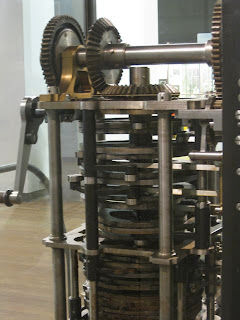I spent my last day in London at the British Library, Westminster Abbey, and walking the West End. The British Library, sadly, does not allow photography in their manuscript viewing room, so I can't show you any of the fabulous illuminated manuscripts or other historically interesting books I saw. (I also can't show you the Chaucer manuscript, but that's because it wasn't on display. Hmph.)
Things I learned at the British Library:
- Handwriting hasn't changed substantially in the last several hundred years, because I can still make out words penned centuries ago.
- 200 years ago, they were still writing in chicken scratch rather than proper handwriting
- I've always thought illuminated manuscripts got touched up for their scans, much like fashion models. This is not true. The colors really are still that vivid and solid.
- Gutenberg Bibles were BIG. Also printed without initials so purchasers could personalize their books with the local art styles.
- Medieval drawings of humans look less stilted and stylized in person.
- There are some phenomenally well-preserved books from the Middle Ages.
- Everyone illustrated manuscripts, including the Persians, Indians, Chinese, and, of course, the Muslims.
- The Chinese were block-printing way before anyone else was.
- The Beatles wrote lyrics on some very strange things.
- Bookbinding is beautiful, but not nearly as interesting as illumination.
Then it was on to Westminster Abbey, which also doesn't allow photographs inside. I definitely recommend going, especially if you have a historical bent, and also recommend getting the audio tour. It points out things you wouldn't necessarily notice otherwise, because there's no map or guidebook available. First off, though, the exterior!
I've been in some really dark and oppressive Gothic holy buildings, and in some light and airy ones. Westminster Abbey is definitely light and airy—and, like any regularly used historical church, full of more recent architectural styles as well. In this case, those styles are mainly for tombs, but I've seen mashups in central Europe where parts of the church were actually rebuilt. I'm very glad that didn't happen at the Abbey. Still, the massive amount of baroque and Victorian tombs and memorials (and the occasional Tudor one) were a bit jarring. The highly worn medieval ones fit a lot better into the aesthetic.
I found the tombs interesting, though. A lot of political and military leaders, and nobles, are either buried or remembered in Westminster Abbey, to the point that it's hard to see some of the statues in detail because there are three or four other statues in the way. A lot of the gravestones in the floor have also been worn down by foot traffic so are hard to read. The Tudor royalty were big on elaborate tombs of the "I need a better tomb than my dad" variety. Absolutely gorgeous work, though. Intricate. Lifelike statues.
I was the odd one out in the respects I paid to the memorials too, I think. Most people seemed to be there for the nobility, clustering around Queen Elizabeth I's tomb, or Henry V's. Poet's Corner was pretty crowded too (not that anywhere wasn't), but I got the impression that people were there just to say they'd been, rather than to see specific memorials. And, of course, there were the handful of people who'd actually come to Westminster Abbey for religious reasons. Me? I paid respect to Chaucer, Shakespeare, Handel, Darwin, Newton, Clementi, Addison, Blake, the Brontës, Watt, and a host of other literary and scientific figures I recognized. I was more excited to find Blake than I did to find Cromwell, who's also buried there.
All good abbeys have a cloister, which I sat in a while because my legs were tired from walking. It's cool and calm, and, wonderfully, allows photography because it's outside!
Those are medieval limestone coffins with holes carved for the head.
The back of the cathedral has a row of statues of 20th-century religious martyrs:
Opposite the abbey are, of course, the Houses of Parliament:
I headed for the West End next, because of Forbidden Planet, because I wanted to see the theatre district a bit, and because there was a ghost walk meeting there that evening. Forbidden Planet was more like a department store than I'd expected, but definitely cool. The theatre district was also neat to see, but also tempting. I almost didn't go on the ghost walk after all.
The walk itself was more history and fewer ghosts than I'd expected. There can't have been more than six or seven ghosts for the two hour tour. I'd thought a city as old as London would have been more haunted, but maybe the guide only picked the highlights. He was a good storyteller, if a bit of a ham and overly fond of invading personal space for dramatic effect. Most of his stories followed the urban legend formula—an unnamed friend or client just the other week had seen a ghost right there….
None of the pictures I took on the walk have ghosts in them, but they're still good.
After the walk, I hopped the tube back to the hostel. I caught a plane out the next morning. I have to go back someday, no question.
























































